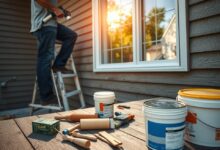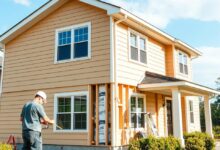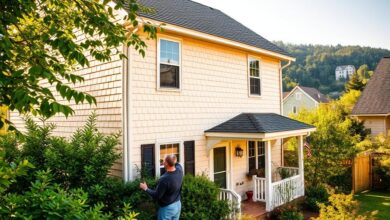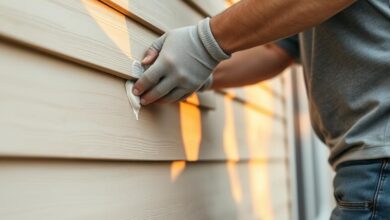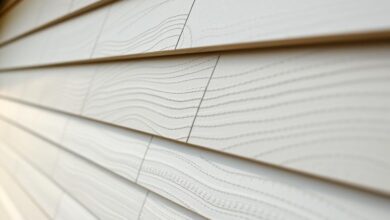Insulated Siding for Better Home Insulation
Homeowners are always searching for ways to make their homes more energy-efficient. Insulated siding is a great solution. It not only makes your home look better but also protects it from the weather.
Installing insulated siding helps a lot. It keeps your home warm in winter and cool in summer. This means you use less energy and pay less for utilities. It’s a smart choice for saving money.
As energy costs go up, it’s key to improve home insulation. Insulated siding is a smart and effective way to do this. It makes your home more comfortable and sustainable.
Key Takeaways
- Reduces heat loss and keeps homes cooler in summer
- Lowers energy consumption and utility bills
- Enhances the exterior of your home
- Contributes to a more sustainable living environment
- Increases the overall energy efficiency of your home
What Is Insulated Siding and How Does It Work?
Insulated siding is a new way to make homes more energy-efficient. It helps keep your home cozy and cuts down on energy use.
The Structure of Insulated Siding
Insulated siding has several layers. It has foam insulation in the middle, between the siding and the sheathing. This multi-layered structure helps block heat and air leaks.
How It Improves Home Energy Efficiency
Insulated siding makes homes more energy-efficient. It does this by:
- Keeping heat in during winter
- Lowering energy costs
- Keeping the indoor temperature steady
So, insulated siding is a great choice for those wanting a more energy-efficient and comfortable home.
Benefits of Insulated Siding for Better Insulation
Insulated siding is great for homeowners wanting to save energy and feel more comfortable at home. It makes your home look better and works better too.
Energy Savings and Reduced Utility Bills
Insulated siding stops heat from moving in and out of your home. This means you use less energy and pay less for utilities. The U.S. Department of Energy says you could save up to 15% on your energy bills.
| Insulation Type | Energy Savings |
|---|---|
| Insulated Siding | Up to 15% |
| Traditional Siding | 0-5% |
Noise Reduction Properties
Insulated siding also makes your home quieter. It absorbs sound, so you hear less outside noise.
“The added insulation in our siding has made a significant difference in reducing the noise level in our home. We’re much more comfortable now.” –
Improved Structural Integrity
Insulated siding also makes your home stronger. It protects your home from bad weather and other damage.
Enhanced Curb Appeal
Lastly, insulated siding makes your home look better. You can pick from many styles and colors to match your home’s look.
Top Vinyl Insulated Siding Options
Homeowners have many choices for vinyl insulated siding. ProVia and CertainTeed are two top brands. They offer quality products that are good at keeping your home warm, durable, and look great.
ProVia Insulated Vinyl Siding
Overview
ProVia Insulated Vinyl Siding is known for its high quality. It helps make your home more energy efficient and looks better.
- Excellent Insulation: ProVia’s siding keeps your home warm in winter and cool in summer.
- Durable: It’s made to last, resisting damage from weather and more.
Cons
- Higher Cost: ProVia siding costs more than some other brands.
- Limited Color Options: While ProVia has many colors, there are fewer than some brands.
Features
ProVia siding has a foam backing for better insulation and strength. It’s also easy to keep clean, as it resists dirt and debris.
Recommendations
Choose ProVia if you want your home to be energy efficient and durable. It’s a premium product worth the investment.
CertainTeed Insulated Vinyl Siding
Overview
CertainTeed Insulated Vinyl Siding is a top choice. It offers energy savings and looks good too.
Pros
- Energy Efficiency: It helps lower your energy bills by keeping your home at a comfortable temperature.
- Wide Range of Styles: CertainTeed has many styles and colors, so you can make your home look exactly how you want.
Cons
- Installation Challenges: Some people find it hard to install, but it’s worth it for the benefits.
- Cost Variability: The price can change based on the product and how it’s installed.
Features
CertainTeed siding is tough and weather-resistant. It comes with a long warranty, giving you peace of mind.
Recommendations
CertainTeed is a good choice if you want energy savings, durability, and style. It’s perfect for those who want a reliable product with many options.
Best Fiber Cement Insulated Siding Products
Homeowners looking for durable and energy-saving siding should check out James Hardie and Nichiha. These brands lead the market with their fiber cement insulated siding. They offer benefits that boost your home’s performance and look.
James Hardie Insulated Siding
Overview
James Hardie is a top name in siding, known for its quality fiber cement. Their insulated siding is made to save energy and last long.
Pros
- Durability: James Hardie siding stands up to weather, pests, and fire.
- Energy Efficiency: Its insulated backing keeps homes warm in winter and cool in summer.
Cons
- Cost: James Hardie siding might cost more than other options.
- Installation: It needs skilled labor, which can increase the cost.
Features
James Hardie’s insulated siding has many features. It comes in various textures and colors. It also has a special backing to reduce heat transfer.
Recommendations
For durable and energy-saving siding, James Hardie is a good choice. It’s best for homes in extreme weather areas.
Nichiha Fiber Cement Insulated Siding
Overview
Nichiha is a well-known brand in fiber cement siding. They offer high-performance insulated siding. Their siding looks good and works well.
Pros
- Aesthetic Versatility: Nichiha has many styles and finishes for different looks.
- Moisture Resistance: Their siding can handle moisture, preventing damage.
Cons
- Limited Availability: Nichiha products might be harder to find.
- Higher Upfront Cost: Nichiha siding is durable but costs more at first.
Features
Nichiha’s siding is made with advanced technology. It’s durable and has many design options.
Recommendations
Nichiha is perfect for those who want both beauty and function. It’s great for homes in harsh weather and keeps looking good over time.
James Hardie and Nichiha offer top-notch fiber cement insulated siding. They improve your home’s energy use and look. Knowing the pros and cons helps homeowners choose the best for their needs.
Installation Considerations for Insulated Siding
Getting the most out of your insulated siding starts with careful installation. A good installation ensures the siding works well. It helps with energy savings and lasts longer.
Professional vs. DIY Installation
Homeowners must decide between professional or DIY installation. DIY can save money but needs special skills and tools. Professional installation means the job is done right and fast, avoiding mistakes.
Preparation Requirements
Before installing, the home’s exterior must be ready. Check for damage, clean the surface, and remove old siding. Good preparation leads to a successful install.
Common Installation Challenges
Installing insulated siding can face challenges like uneven surfaces and tricky spots around windows and doors. Experienced installers know how to overcome these issues for a smooth process.
Best Practices for Optimal Performance
To make insulated siding work best, follow key installation steps. Make sure it’s securely attached, all seams are sealed, and it’s aligned right. As
“Proper installation is key to maximizing the benefits of insulated siding,”
says a leading expert in the field.
Cost Analysis and Return on Investment
Understanding the costs and benefits of insulated siding is key for homeowners. It’s important to know the upfront costs and long-term savings. This helps in making smart choices for home upgrades.
Average Pricing for Different Types
The price of insulated siding changes based on the material. Vinyl insulated siding is often cheaper, costing $6 to $12 per square foot. On the other hand, fiber cement insulated siding is pricier, at $10 to $15 per square foot. This is because it’s more durable and withstands weather better.
| Siding Type | Cost per Square Foot | Installation Cost |
|---|---|---|
| Vinyl Insulated Siding | $6 – $12 | $3 – $5 |
| Fiber Cement Insulated Siding | $10 – $15 | $5 – $7 |
Long-term Energy Savings
Insulated siding is great for saving energy. It adds an extra layer of insulation, keeping your home at a steady temperature. This means you use less energy for heating and cooling. You could save 10% to 30% on your energy bills, depending on your location and the siding’s efficiency.
Tax Credits and Incentives
There are tax credits and incentives for energy-efficient siding. The Residential Renewable Energy Tax Credit and local programs can lower the initial cost. This makes insulated siding a more appealing choice.
Who Should Invest in Insulated Siding
Those living in very cold or hot climates will see the most benefits. Insulated siding also adds value to your home and reduces outside noise. It’s a smart investment for many homeowners.
Conclusion
Insulated siding brings many benefits to homeowners. It makes homes more energy-efficient and comfortable. It reduces heat transfer and air leaks, lowering utility bills and improving living spaces.
Homeowners have many choices, like vinyl and fiber cement from ProVia, CertainTeed, James Hardie, and Nichiha. It’s important to pick the right one for their needs. Proper installation is key for the best results, whether done by a pro or DIY.
Insulated siding offers long-term savings on energy, less noise, and stronger structures. It’s a smart choice for improving a home’s value and appeal.



